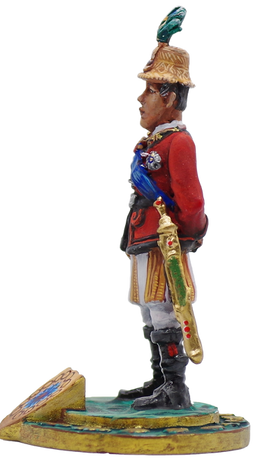
Thutob Namgyal
Chogyal of Sikkim
Thutob Namgyal (1860 – 11 February 1914) was the ruling chogyal (monarch) of Sikkim between 1874 and 1914. Thutob ascended to the throne succeeding his half-brother Sidkeong Namgyal who died issueless. Differences between the Nepalese settlers and the indigenous population during his reign led to the direct intervention of the British, who were the de facto rulers of the Himalayan nation. The British ruled in favour of the Nepalese much to the discontent of the chogyal, who then retreated to the Chumbi Valley and allied himself with the Tibetans. The British sent a military force (Sikkim expedition), and after a series of skirmishes between the Tibetans and the British near Jelep La, the Tibetans were pushed back and the Chogyal was put under the supervision of John Claude White, who had been appointed Political Officer in 1889. In 1894, he shifted the capital from Tumlong to the present location, Gangtok.


The Khampa warriors of Tibet were a group of Tibetan fighters who were known for their bravery and martial prowess. They were also known as “Khampas,” which means “warrior” in the Tibetan language. The Khampas were known for their fierce resistance to Chinese rule in Tibet, and they played a significant role in the Tibetan resistance movement. According to Tibetan folklore, the Khampas were believed to be descended from the gods, and they were revered as great warriors and protectors of the Tibetan people. In Tibetan culture, the Khampas were seen as symbols of bravery and strength, and they were highly respected and admired. Kham is one of the three traditional Tibetan regions, the others being Amdo in the northeast, and Ü-Tsang in central Tibet. The original residents of Kham are called Khampas (Tibetan: ཁམས་པ་, Wylie: khams pa), and were governed locally by chieftains and monasteries. Kham presently covers a land area distributed between five regions in China, most of it in Tibet Autonomous Region and Sichuan, with smaller portions located within Qinghai, Gansu and Yunnan provinces. Densely forested with grass plains, its convergence of six valleys and four rivers supported independent Kham polities of Tibetan warrior kingdoms together with Tibetan Buddhist monastic centers. The early trading route between Central Tibet and China traveled through Kham, and Kham is said to be the inspiration for Shangri-La in James Hilton's novel. Settled as Tibet's eastern frontier in the 7th century, King Songtsen Gampo built temples along
its eastern border. In 1837, a minor chieftain Gompo Namgyal, of Nyarong in eastern Kham, began expanding his control regionally and launched offensives against the Hor States, Litang, Degé, the Chakla and Batang, becoming the paramount power in the region. China sent troops in against Namgyal which were defeated in 1849, and additional troops were not dispatched. Chinese military posts were present along the trading route, but "did not have any authority over the native chiefs". By 1862, Namgyal blocked trade routes from China to Central Tibet, and sent troops into China. Local chieftains had appealed to both the Lhasa and the Qing Manchu governments for help against Namgyal. The Tibetan authorities sent an army in 1863, and defeated Namgyal then killed him at his Nyarong fort by 1865. Central Tibet reasserted its authority over the northern parts of Kham and established the Office of the Tibetan High Commissioner to govern. Tibet also reclaimed Nyarong, Degé and the Hor States north of Nyarong. China recalled their forces. It appears to have been accepted by the Manchu Tongzhi Emperor. Then in 1896, the Qing Governor of Sichuan attempted to gain control of Nyarong valley during a military attack. After his defeat, the Qing agreed to the withdrawal of Chinese forces and the "territory was returned to the direct rule of Lhasa"

The Chogyal were the monarchs of the former Kingdom of Sikkim, which belonged to the Namgyal dynasty. The Chogyal was the absolute monarch of Sikkim from 1642 to 1973, and the constitutional monarch from 1973 to 1975, when the monarchy was abolished and the Sikkimese people voted in a referendum to make Sikkim the 22nd state of India. From 1642 to 1975, Sikkim was ruled by the Namgyal Monarchy (also called the Chogyal Monarchy), founded by Phuntsog Namgyal, the fifth-generation descendant of Guru Tashi, a prince of the Minyak House who came to Sikkim from the Kham province of Tibet. Chogyal means 'righteous ruler', and was the title conferred upon Sikkim's Buddhist kings during the reign of the Namgyal Monarchy. The reign of the Chogyal was foretold by the patron saint of Sikkim, Guru Rinpoche. The 8th-century saint had predicted the rule of the kings when he arrived in the state. In 1642, Phuntsog Namgyal was crowned as Sikkim's first Chogyal in Yuksom. The crowning of the king was a great event and he was crowned by three revered lamas who arrived there from three different directions, namely the north, west, and south.
Awards: Collar, sash and star of the Most Eminent Order of the Indian Empire.






